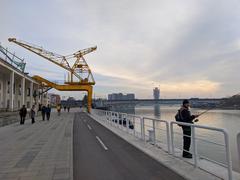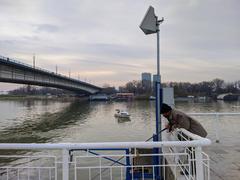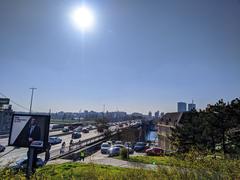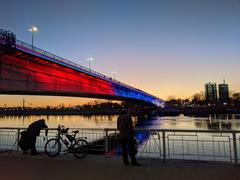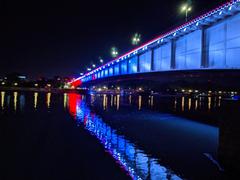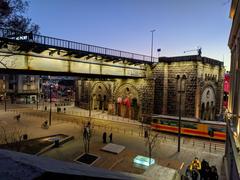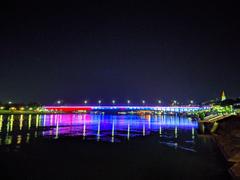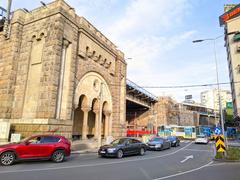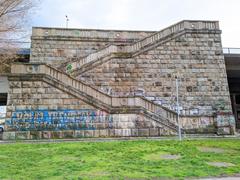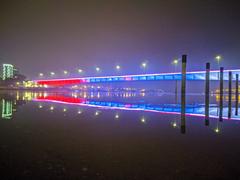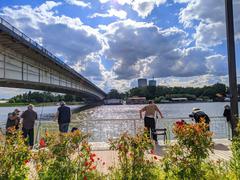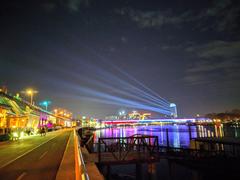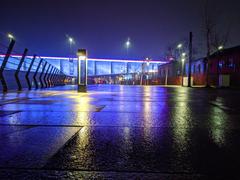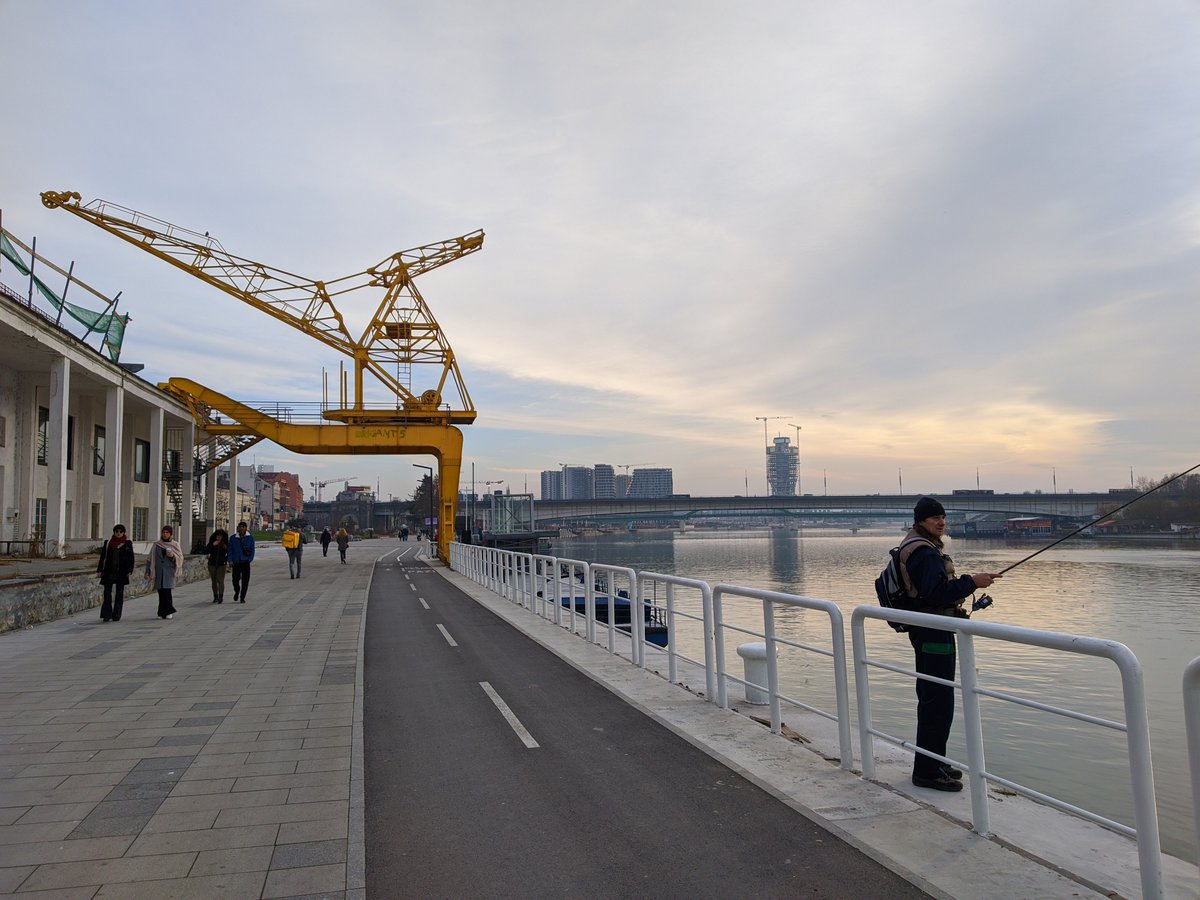
Branko’s Bridge Belgrade, Serbia: Visiting Hours, Tickets, and Travel Guide
Date: 14/06/2025
Introduction
Branko’s Bridge (Brankov most) is one of Belgrade’s most recognizable landmarks, elegantly spanning the Sava River and connecting the city’s historic center with the modern district of New Belgrade. More than a physical connector, the bridge embodies Belgrade’s spirit of resilience, cultural evolution, and urban dynamism. Originally built as the King Alexander Bridge in 1934, destroyed during World War II, and reconstructed in the 1950s, the bridge today stands as a vital artery and a prominent symbol of the Serbian capital’s past, present, and future.
This guide provides a comprehensive overview of Branko’s Bridge, including its history, architectural features, visiting hours, accessibility, nearby attractions, and practical travel tips to help you make the most of your visit.
For further details and inspiration, consult resources like Visit Belgrade, More Than Belgrade, and Minube.
Table of Contents
- Introduction
- Historical Overview
- Visiting Branko’s Bridge: Practical Information
- FAQ: Common Questions
- Visuals and Interactive Elements
- Related Articles
- External Resources
Historical Overview
Early Conception and Strategic Importance
The original bridge at this site, King Alexander Bridge, was completed in 1934 to unite Belgrade’s historic city with the newly developing areas across the Sava River. It played a crucial role in the city’s expansion and modernization, symbolizing national unity during King Alexander I’s reign (Visit Belgrade).
Destruction and Reconstruction
In 1941, the bridge was destroyed by Yugoslav forces during World War II. The 1950s saw its rebirth—rebuilt atop the original pylons and reopened as Branko’s Bridge in 1956. The new name honors poet Branko Radičević, reflecting a shift towards celebrating Serbian literary and cultural figures (Visit Belgrade).
Architectural Features and Engineering
Branko’s Bridge is a steel girder bridge, about 450 meters long and 22–40 meters wide, accommodating six traffic lanes and pedestrian walkways on both sides. The design emphasizes functionality and durability, characteristic of mid-20th-century Yugoslav engineering. In the 1970s, the bridge was widened to handle increased traffic, and regular renovations ensure its continued structural integrity (Visit Belgrade).
Urban Role and Development
Strategically connecting Stari Grad, Savamala, and New Belgrade, Branko’s Bridge is a vital transportation artery. It supports tens of thousands of vehicles and pedestrians daily, facilitating economic and social integration between Belgrade’s traditional and modern neighborhoods (More Than Belgrade).
Cultural and Symbolic Significance
Named after Branko Radičević, the bridge is more than infrastructure—it is a cultural icon regularly featured in literature, art, and film. It forms a gateway between Belgrade’s old and new faces, and its proximity to landmarks like Kalemegdan Fortress and the Sava Promenade further enhances its status (More Than Belgrade).
Modern Challenges
With its essential urban role, Branko’s Bridge faces challenges such as traffic congestion and the need to harmonize with ambitious urban projects like the Belgrade Waterfront. Ongoing maintenance and modernization efforts aim to preserve its safety and historical value (academia.edu).
Visiting Branko’s Bridge: Practical Information
Visiting Hours
Branko’s Bridge is a public thoroughfare and remains open 24/7 for pedestrians, cyclists, and vehicles. There are no restrictions on access at any time of day or night.
Tickets and Access
No ticket or entrance fee is required. The bridge can be crossed freely by foot, bicycle, or car.
Accessibility
The bridge is equipped with pedestrian walkways on both sides, protected from traffic by barriers. A panoramic elevator on the New Belgrade side increases accessibility for wheelchair users and those with mobility challenges. Approach ramps may be steep in places, so visitors are advised to take care.
Guided Tours
While there are no dedicated guided tours exclusively for Branko’s Bridge, the bridge is frequently included as a highlight in city walking and cycling tours. These tours often explore the bridge’s history, engineering, and cultural significance. Check with local tour providers for schedules (Visit Belgrade).
Nearby Attractions
- Kalemegdan Fortress: Historic fortress and park with panoramic river views.
- Sava Promenade: Riverside walkway with cafes, floating clubs (splavovi), and recreational areas.
- Savamala District: Lively area known for nightlife, art galleries, and street art.
- New Belgrade: Modern cityscape with shopping centers and Beogradska Arena.
Best Times to Visit and Photography Tips
Early morning and late afternoon offer the best light for panoramic photography. Evenings are popular for capturing the illuminated bridge and enjoying riverfront nightlife. Weekday mornings and evenings are generally less crowded.
FAQ: Common Questions
Is Branko’s Bridge free to visit?
Yes, access is free at all times.
What are the best photo spots?
Panoramic views are best from the pedestrian walkways, Kalemegdan Fortress, and the Sava Promenade.
Can I cycle across the bridge?
Yes, dedicated cycling paths are available.
Is the bridge accessible for people with disabilities?
Yes, though some ramps may be steep. The panoramic elevator on the New Belgrade side aids accessibility.
Are guided tours available?
The bridge is included in many city walking and cycling tours.
Is the area safe at night?
Yes, the bridge is well-lit and frequented by locals at all hours.
Visuals and Interactive Elements
- Images: Panoramic views of Branko’s Bridge at sunset, nighttime illumination, and historic photos of the original King Alexander Bridge.
- Alt tags: “Branko’s Bridge panoramic sunset view”, “Night illumination of Branko’s Bridge Belgrade”
- Interactive Map: Embed a map highlighting the bridge’s location and nearby landmarks.
- Virtual Tours: Link to online resources for a virtual walk across the bridge and surrounding districts.
Related Articles
External Resources
Recommendations for a Memorable Visit
- Combine your visit to Branko’s Bridge with a walk through Savamala and a stop at the Sava Promenade.
- Plan a sunset stroll for the most striking views and photographs.
- Consider a river cruise for a unique perspective of the bridge and city skyline.
- Explore both sides of the river to experience the contrast between old and new Belgrade.
- Check local event calendars for festivals and public events that may enhance your visit.
Summary
Branko’s Bridge is not just a functional crossing but an enduring symbol of Belgrade’s heritage, urban transformation, and community spirit. Its utilitarian architecture stands in contrast with the city’s historic and modern skylines, serving as a living narrative of resilience and connectivity. With free, 24/7 access for pedestrians and vehicles, proximity to key attractions, and a vibrant surrounding urban scene, the bridge is a must-see for any visitor to Belgrade.
For further information and traveler reviews, visit Visit Belgrade, More Than Belgrade, and Minube.
References and Further Reading
- Visit Belgrade – Tourist Information
- More Than Belgrade – The Bridges of Belgrade
- Minube – Branko Bridge
- Belgrade Public Transport
- Belgrade Tourism Board
